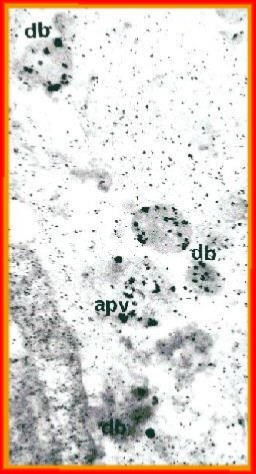

The images on this page are electron micrographs of tissue which has
been gently preserved to maintain enzyme viability, but not counterstained
at all. This explains why there are relatively few details to be seen.
Normally an electron micrograph depends on the adherence of electron opaque
materials (such as lead or uranium) on to membranes and organelles so that
they show up, essentially, as shadows in the electron beam of the electron
microscope. Instead, the tissues have been soked in a specially prepared
solution so that the action of enzymes on the substrate in the solution
generates a preciptated deposit of electron-opaque material.

For example, the enzyme acid phosphatase can be demonstrated using the method of Gomori (1950), which involves a buffered solution. "Buffered" means that the pH (acidity/alkalinity) of the solution is controlled - in this case a 0.05M acetate buffer held the pH at 5.0 (i.e. acid; pH = 7.0 is neutral). In the Gomori medium, the substrate is sodium β-glycerophosphate (0.01M) together with lead nitrate (0.004M) - both of these compounds being soluble at these concentrations. The action of the enzyme, acid phosphatase, is to cleave the glycerophosphate to produce free phosphate ions, which combine with the lead ions to produce insoluble lead phosphate. This deposit is opaque to electrons and so shows up in the e.m. to localize the enzyme for us.
A control is necessary to verify that the deposit is due to the enzyme - this is achieved by doing the same incubation, but without the substrate (sodium β-glycerophosphate).
In these examples from the retinula cells of Mitopus morio, tissues were incubated in a Gomori acid phosphatase medium (pH5.0) with glycerophosphate as substrate. Incubation was for 60minutes at a temperature of 22°C . Lysosomal organelles such as dense bodies and autophagic vacuoles showed most noticeable reaction deposit.
In this first image, an autophagic vacuole (apv) and three dense bodies (db) are included showing fairly large clumps of reaction product - indicating acid phosphatase. Much cytoplasmic non-specific deposition is also apparent.
In this second image, dense bodies (db) show very dense deposits
of reaction product, which is easily distinguished from the non-specific
staining of the cytoplasm.
As mentioned above, we need a control to verify that the deposits are due to enzymic activity. In this case it is achieved by incubation in the absence of the substrate and you can see the result in the image mouse-over.
Control material, incubated in the absence of substrate, shows only
random, non-enzymic deposition of lead phosphate. The dense bodies (db)
show no more deposition than the general cytoplasm.
The enzyme localized in our mystery picture for October is, in fact, non-specific esterase.
The incubation medium used for this was also the Gomori method, of 1952
with acetylthiocholine as substrate. Here the insoluble electron-dense
reaction product is copper thiocholine.
This can be distinguished from specific acetylcholine esterase (AChE)
by the use of the inhibitor 62C47 (1:5-bis-(4-trimethylammoniumphenyl)pentan-3-one
di-iodide) which specifically stops the action of AChE but only has a very
slight effect on the non-specific esterase. It is particularly interesting
to note the presence of peri-rhabdomeric
acetylcholine esterase.
This non-specific esterase is associated with lysosomal organelles -
various vesicles and larger organelles, such as dense bodies.
For further details, see:
Curtis, D.J. (1969) The fine structure of photoreceptors in Mitopus
morio (Phalangida). J. Cell Sci., 4: 327-351.
 |
Back to Opilio Notes | or | Back to Arachnologia |
 |
Back to Home page |